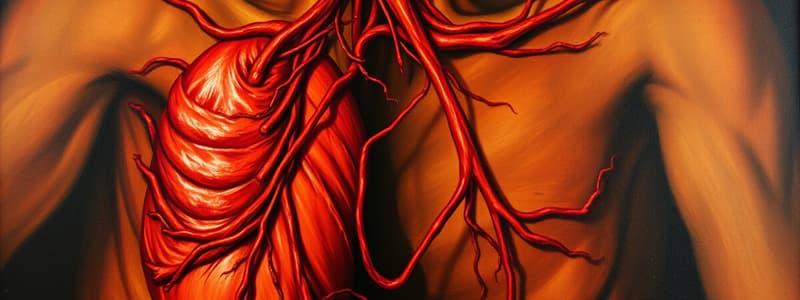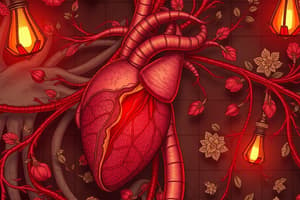Podcast
Questions and Answers
Normal hemostasis can result in the formation of a hemostatic plug only at the site of vascular injury.
Normal hemostasis can result in the formation of a hemostatic plug only at the site of vascular injury.
True (A)
The endothelial cells primarily promote thrombosis by enhancing platelet aggregation and coagulation.
The endothelial cells primarily promote thrombosis by enhancing platelet aggregation and coagulation.
False (B)
Endothelial cells have no role in regulating fluid homeostasis in blood circulation.
Endothelial cells have no role in regulating fluid homeostasis in blood circulation.
False (B)
Under certain conditions, endothelial cells can exhibit procoagulant activities after activation or injury.
Under certain conditions, endothelial cells can exhibit procoagulant activities after activation or injury.
Fibrinolytic effects are one of the properties that endothelial cells exhibit under normal conditions.
Fibrinolytic effects are one of the properties that endothelial cells exhibit under normal conditions.
Endothelial injury does not lead to the adhesion of platelets to the underlying extracellular matrix.
Endothelial injury does not lead to the adhesion of platelets to the underlying extracellular matrix.
Thrombin, along with ADP and thromboxane A2, is involved in making the platelet aggregation process irreversible.
Thrombin, along with ADP and thromboxane A2, is involved in making the platelet aggregation process irreversible.
Platelet contraction occurs before platelet aggregation in the hemostatic process.
Platelet contraction occurs before platelet aggregation in the hemostatic process.
Dense body granules in platelets contain adenine nucleotides such as ADP and ATP.
Dense body granules in platelets contain adenine nucleotides such as ADP and ATP.
Endothelial cells exclusively induce synthesis of thromboxane A2 in response to bacterial endotoxin.
Endothelial cells exclusively induce synthesis of thromboxane A2 in response to bacterial endotoxin.
The primary hemostatic plug formed during platelet aggregation is irreversible.
The primary hemostatic plug formed during platelet aggregation is irreversible.
Inhibitors of plasminogen activator (PAIs) are secreted by endothelial cells to regulate fibrinolytic activity.
Inhibitors of plasminogen activator (PAIs) are secreted by endothelial cells to regulate fibrinolytic activity.
Plasminogen is an active precursor that directly breaks down fibrin.
Plasminogen is an active precursor that directly breaks down fibrin.
Thrombosis can occur without the need for physical damage to the endothelial surface.
Thrombosis can occur without the need for physical damage to the endothelial surface.
Stasis is a major factor in the formation of arterial thrombi.
Stasis is a major factor in the formation of arterial thrombi.
Hypercoagulability can be classified into primary and secondary disorders.
Hypercoagulability can be classified into primary and secondary disorders.
Thrombi can only develop in veins, excluding arteries and capillaries.
Thrombi can only develop in veins, excluding arteries and capillaries.
Thrombin converts fibrinogen into fibrin, which then stabilizes the clot.
Thrombin converts fibrinogen into fibrin, which then stabilizes the clot.
The coagulation cascade amplifies the activity of active enzymes into inactive proenzymes.
The coagulation cascade amplifies the activity of active enzymes into inactive proenzymes.
Antithrombin III serves to enhance the activity of thrombin in the clotting process.
Antithrombin III serves to enhance the activity of thrombin in the clotting process.
Fibrinolysis is primarily achieved through the action of thrombin.
Fibrinolysis is primarily achieved through the action of thrombin.
Proteins C and S are both vitamin K-dependent and help inactivating cofactors Va and VIIIa.
Proteins C and S are both vitamin K-dependent and help inactivating cofactors Va and VIIIa.
Plasminogen is activated by thrombin during fibrinolysis.
Plasminogen is activated by thrombin during fibrinolysis.
The coagulation assay can be evaluated using PT, PTT, and INR.
The coagulation assay can be evaluated using PT, PTT, and INR.
Urokinase-like PA (u-PA) is responsible for deactivating plasmin in the body.
Urokinase-like PA (u-PA) is responsible for deactivating plasmin in the body.
Fibrin forms an insoluble gel that encapsulates platelets and other cells in the clot.
Fibrin forms an insoluble gel that encapsulates platelets and other cells in the clot.
Three categories of natural anticoagulants include antithrombin, proteins C, and tissue factor pathway inhibitor.
Three categories of natural anticoagulants include antithrombin, proteins C, and tissue factor pathway inhibitor.
Flashcards are hidden until you start studying
Study Notes
Hemodynamic Disorders, Thrombosis, and Shock
- Intact circulation is crucial for delivering oxygen and removing waste from cells and tissues.
- Blood must remain in a liquid form until clot formation is necessary for hemostasis.
Hemostasis and Thrombosis
- Normal hemostasis maintains blood in a fluid state while quickly forming a localized hemostatic plug after vascular injury.
- Three components involved: vascular wall, platelets, and the coagulation cascade.
Endothelium
- Endothelial cells have opposing roles in hemostasis, balancing anti-thrombotic and pro-thrombotic activities.
- Baseline states promote liquid blood flow through antiplatelet, anticoagulant, and fibrinolytic properties.
- Endothelial injury promotes thrombus formation via platelet adhesion influenced by von Willebrand factor (vWF).
Antithrombotic Properties
- Antiplatelet Effects: Prevent platelet adhesion through prostacyclin (PGI2) and nitric oxide.
- Anticoagulant Effects: Include heparin-like molecules and thrombomodulin.
- Fibrinolytic Properties: Mediated by tissue plasminogen activator (t-PA) which breaks down clots.
Prothrombotic Properties
- Endothelial injury triggers platelet adhesion due to vWF.
- Activated endothelial cells can produce tissue factor, initiating coagulation.
- Secretion of plasminogen activator inhibitors (PAIs) can inhibit fibrinolysis.
Platelets
- Platelets are essential for hemostasis, mediating adhesion through vWF and exposed collagen.
- Secretion: Release of dense granules occurs post-adhesion, containing ADP, ATP, calcium, and serotonin.
- Aggregation: Initiated by ADP and thromboxane A2, forming a primary, reversible hemostatic plug.
- Thrombin converts fibrinogen to fibrin, leading to the formation of an irreversible secondary hemostatic plug.
Coagulation Cascade
- Series of enzymatic conversions culminating in thrombin that converts fibrinogen into fibrin.
- Localized activation is vital to prevent systemic clotting.
- Control of the cascade is managed by natural anticoagulants, including antithrombin III and proteins C and S.
Thrombosis Pathogenesis
- Virchow's Triad: Key influences on thrombus formation include endothelial injury, blood flow stasis or turbulence, and blood hypercoagulability.
Endothelial Injury
- Can occur without physical disruption of the endothelium, affecting the balance between pro- and anti-thrombotic states.
Alterations in Blood Flow
- Turbulent flow causes endothelial injury and stasis, majorly contributing to venous thrombus development.
Hypercoagulability
- Defined as any alteration in coagulation pathways predisposing to thrombosis, categorized into primary (genetic) and secondary (acquired) conditions.
Morphology of Thrombi
- Can form in any part of the cardiovascular system; venous thrombi commonly found in the legs.
- Superficial thrombi cause local symptoms, while deep thrombi pose risks of embolization.
Cardiac and Arterial Thrombosis
- Atherosclerosis is a primary trigger due to endothelial integrity loss and abnormal flow.
- Mural thrombi can arise from myocardial infarctions or rheumatic heart disease.
Embolism
- An embolus is a mass (solid, liquid, or gas) transported through blood, with most being dislodged thrombi (thromboembolism).
- Can lead to ischemic necrosis (infarction) of downstream tissues.
Pulmonary Thromboembolism
- Incidence rates range from 20-25 per 100,000 hospitalized patients.
- Despite a decline in fatality rates, pulmonary embolism still accounts for approximately 200,000 deaths annually in the U.S.
Studying That Suits You
Use AI to generate personalized quizzes and flashcards to suit your learning preferences.




